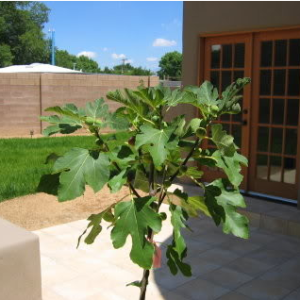This site contains affiliate links for which I may be compensated.
Melanzana
Melanzana Information


-
Possible Synonyms / AKA:
Merengiana
-
Introduced By:
-
Origin:
Italy -
Main Flavor Group:
-
Family Group:
-
Fig Type:
Common - Self fertile and will grow anywhere conditions are suitable -
Cold Hardy:
N/A -
Container Variety:
Yes -
Easy Rooting:
N/A -
Main Season:
any -
Availability:
N/A -
Breba Crop:
N/A -
Seed Crunch:
N/A -
Eye:
open -
Skin Toughness:
N/A -
Fruit Size:
N/A -
Rain Resistance:
N/A -
Tree Vigor:
N/A -
External Links:
Description
Leon_Edmond:
Bass, this Melanzana Merdoscola is different from a "Melanzana" I acquired several years from the source listed below. If you click on the link, it should bring you to a descriptor page of the fig varieties. My Melanzana trees produced an abundant crop of absolutely delicious figs. The only problem, it dropped almost all of it's fruit 3 seasons in a row and finally I gave up on it. I had one potted tree and another in the ground and they behaved the same way.
Ironically, a number of forum members who acquired the same Melanzana, experienced the same issue. I hope that some will read this and share their experience. One fellow asked the owner if he was aware of the Fruit Drop problem and he said that over time, this Melanzana would stop doing that. So I often reflect on whether I should have given them more time but my patience finally ran out.
Ironically, a number of forum members who acquired the same Melanzana, experienced the same issue. I hope that some will read this and share their experience. One fellow asked the owner if he was aware of the Fruit Drop problem and he said that over time, this Melanzana would stop doing that. So I often reflect on whether I should have given them more time but my patience finally ran out.
Adriano:
A rich flavor, super qality, reddish brown large fig from Italy. Its tree
is very vigorous. the Breba first crop is huge. It ripens early. Good
pot plant.
Condit Monograph
Melanzana = Merengiana
Merengiana (may not refer to Melanzana Merdoscola): (syns. Marangiano, Melanciano, Melanzana, Parmigiano, Dottato Nero or Rosso, Ficus carica melitensis Risso). Described by Risso (1826), Sauvaigo (1889), Eisen (1901), Guglielmi (1908), Vallese (1909, with illustrations of leaves and fruit), and DE Rosa (1911). F. carica melitensis, or Figue DE Malta, described by Risso, was recorded by Sauvaigo as Merengiano. The name Melanciano implies '' Black ,'' while Melanzana suggests resemblance of the color of this fig to that of an eggplant.
According to Vallese, this variety is known in some districts as Dottato Rosso.
Merengiana is grown to a limited extent only in southern Italy, while in France it is found along the Riviera. A variety grown by Italian residents of Washington, D.C., and called by them Eggplant or Melanzana, has fruited at Riverside, California, and proved to be the same as Franciscana.
Leaves of the tree are generally 3-lobed. Description of fruit is after that of Vallese.
Breba crop borne only in favorable years; fruit large, obconical, with rounded apex; color green, tinged with purple on exposed side; pulp pale rose, sweet.
Second-crop figs oblate-spherical (as shown in fig. 75 of Vallese); stalk short; color violet; bloom pruinose; skin readily peeled from meat; pulp light red; flavor sweet, pleasing. Consumed fresh; not much adapted to drying, as it is subject to spoilage in some seasons.
Melanzana = Merengiana
Merengiana (may not refer to Melanzana Merdoscola): (syns. Marangiano, Melanciano, Melanzana, Parmigiano, Dottato Nero or Rosso, Ficus carica melitensis Risso). Described by Risso (1826), Sauvaigo (1889), Eisen (1901), Guglielmi (1908), Vallese (1909, with illustrations of leaves and fruit), and DE Rosa (1911). F. carica melitensis, or Figue DE Malta, described by Risso, was recorded by Sauvaigo as Merengiano. The name Melanciano implies '' Black ,'' while Melanzana suggests resemblance of the color of this fig to that of an eggplant.
According to Vallese, this variety is known in some districts as Dottato Rosso.
Merengiana is grown to a limited extent only in southern Italy, while in France it is found along the Riviera. A variety grown by Italian residents of Washington, D.C., and called by them Eggplant or Melanzana, has fruited at Riverside, California, and proved to be the same as Franciscana.
Leaves of the tree are generally 3-lobed. Description of fruit is after that of Vallese.
Breba crop borne only in favorable years; fruit large, obconical, with rounded apex; color green, tinged with purple on exposed side; pulp pale rose, sweet.
Second-crop figs oblate-spherical (as shown in fig. 75 of Vallese); stalk short; color violet; bloom pruinose; skin readily peeled from meat; pulp light red; flavor sweet, pleasing. Consumed fresh; not much adapted to drying, as it is subject to spoilage in some seasons.
If you'd like your banner to be shown here and throughout Fig Database, send us a message.
Photos Add Your Image
YouTube Videos
No Videos Found










